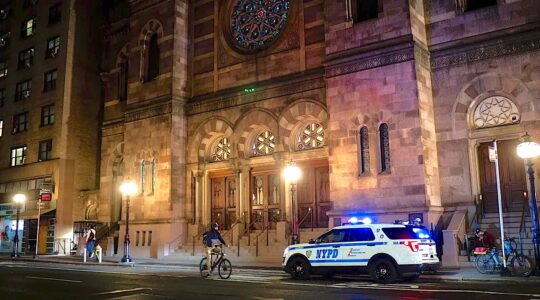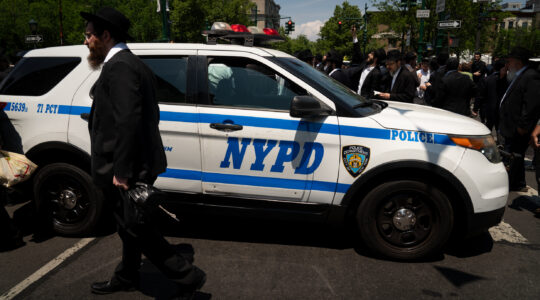When I began traveling to Cuba in 1991, hanging out in the ruined synagogues of Havana to learn the stories of the Jews who remained after Fidel Castro came to power, I suffered from attacks of vertigo.
I was born in Cuba, but left as a child, and growing up in New York in the 1960s I absorbed my family’s nostalgia for Cuba, the tropical island that offered my Ashkenazi and Sephardic grandparents refuge from anti-Semitism and hope for a new beginning. But I was told never to go back, not while communism and Castro remained.
The panic that overcame me when I went to see Cuba with my own eyes was brought on by the emotional weight of returning against my parents’ will. The weight of an internalized embargo.
With time I normalized my relationship with Cuba, even while the American and Cuban governments continued their abnormal relationship. My panic attacks stopped. I studied the Jews of Cuba seriously, getting to know them as individuals who led lives as meaningful as my own.
My trips often coincided with those of American Jews on mitzvah trips to help the Jews of Cuba, a people they found endlessly fascinating. A Cuban Jew myself, I had never thought of Cuban Jews as exotic creatures. But American Jews found the idea of tropical Jews magical. Whether it was memories of Jews dancing mambo in the Catskills, knowledge of Meyer Lansky’s role in Cuba’s corruption, guilt at the U.S. embargo, a desire for rum, cigars, and joy not found on Shoah trips, sorrow at the thought of Jewish life vanishing in a place so close to home, a need for a worthwhile mitzvah destination, or all of the above, American Jews felt passionate about the Jews in Cuba.
The Joint Distribution Committee (JDC) was the first to offer assistance to rebuild the Jewish community. This was in 1991, a time of hunger and uncertainty after Soviet subsidies ended. Fearing political, economic, and moral collapse, the Cuban government opened the door to capitalism and tourism and allowed God back in, permitting Cubans to practice religion after years of enforced atheism.
Cuba didn’t (and doesn’t) have a rabbi. The JDC sent Rabbi Shmuel Szteinhendler from Argentina to reach out to Jews who’d lost touch with their roots in the dogmatic years of the revolution. Young Jewish leaders came from Argentina for two-year stints, teaching Hebrew, liturgy, and Jewish history. The Canadian Jewish Congress had always sent annual Passover packages, but the JDC now paid for weekly Shabbat chicken dinners to create conviviality and compensate for reduced government food subsidies. People came out of the Jewish closet, laying claim to Jewish ancestors, as they still do today. The JDC supported conversions of those with Jewish fathers or partners. Over the next two decades, a Jewish community of about a thousand people was created, as culturally and racially diverse as is Cuba itself.
The U.S. government, interested in promoting free religious expression, encouraged Americans to travel on religious missions despite the embargo. Thousands of American Jews have gone to Cuba legally in groups organized by B’nai Brith, synagogues, Hillels, JCCs and museums. They bring medicine, food, clothing, Jewish prayer books and literary works. Each group rediscovers the miracle of Jewish life in Cuba and returns laden with exhilarating stories and photographs that are shared in the media and beyond, creating hype and more calls for solidarity.
The Jews of Cuba are now part of American Jewish consciousness, just as American Jews are now a fixture of Jewish Cuban life on the island.
So, will anything really change following President Obama’s announcement of an opening toward Cuba?
More American Jewish groups will certainly travel to Cuba. Groups already fill the Beth Shalom Synagogue in Havana during Friday night Kabbalat Shabbat services in the peak tourist season between December and April.
The groups always want to meet personally with Adela Dworin, the charming president of Cuba’s Jewish community. Fluent in Yiddish and English, Dworin is refreshingly low-key, presiding over the community from her desk at the synagogue’s Jewish library, or Biblioteca of the Patranato, which she guarded zealously for years when no one cared about the Jewish legacy.
Support the New York Jewish Week
Our nonprofit newsroom depends on readers like you. Make a donation now to support independent Jewish journalism in New York.
Other leaders are stepping in to assist Dworin at Beth Shalom, including the synagogue’s vice president, David Prinstein, and his wife, Marlen Fernandez Barroto, who heads up the Israeli folk dance program. Different Jewish voices are emerging in Havana, including Mayra Levy at the Centro Sefaradí, who has raised money to create a lively center for Jewish elders, and Adath Israel’s Jacob Berezniak, the only Orthodox religious leader in the country. Outside Havana, David Tacher of Santa Clara has built a new synagogue with American Jewish support. Rebeca Langus of Cienfuegos, Daisy Esther Bernal of Sancti Spiritus, Enma Farín Levy of Santiago de Cuba, and Rodolfo Mizrahi of Guantanamo lead tiny, hopeful Jewish communities out of pure devotion. The importance of women in maintaining Jewish life reflects the egalitarian orientation of the community in Cuba.
The biggest challenge of the community leaders is that they train talented Jewish youth to be leaders, only to see them leave for more prosperous horizons. If economic prospects improve, young Jews might be motivated to stay rather than make aliyah to Israel or dream of Miami.
Perhaps those best positioned to help the community are Cuban-American Jews, or “Jubans.” While many Jubans remain staunchly anti-communist and anti-Castro and won’t set foot in Cuba, several have been involved in restoring Beth Shalom, known as the Patronato to insiders. One prominent Miami Juban businessman recently chartered a plane and took his entire family and three rabbis to Havana to celebrate his grandson’s bar mitzvah at the Patronato. He and other Jubans are eager to invest in Cuba and help rebuild the island’s infrastructure. Unlike American Jews, they speak Spanish and understand the culture of Cuba. Should they choose to become active in the city they left decades ago but never forgot, they might guarantee the future of a living Jewish legacy there.
Expanding Jewish opportunities and Jewish education on the island will be the first priority. Jews in Cuba, like Cubans in general, are not passive recipients of change but active shapers of their futures. When a Lubavitch leader offered to run a summer camp for Jewish children in Cuba, the community was supportive. But when he stipulated that only kids who were Jewish on their maternal side could participate, the community refused to go along. The rule would have excluded most Jewish children of the island. The Lubavitcher had to leave.
In a country where most people, including doctors and engineers, earn only $20 to $40 monthly, the Jewish community needs economic support to sustain itself. But there is now an educated group of Jewish leaders teaching Jewish religious traditions to both children and adults. The lack of a full-time rabbi gives the community a stubborn pride in its independence. The leaders organize communal Passover seders and put on lively Purim parties, where they serve hamantaschen stuffed with guava jelly, a recipe my mother has passed on to me.
What remains less available is Jewish education in a broader sense — knowledge of Jewish history, literature, music, and art. There is hardly any Jewish outreach to the Cuban mainstream. This hopefully will change, as Cubans are deeply curious about Jewish culture. “Schindler’s List” has been shown on Cuban television many times and is a reference point for all discussions of the Holocaust. But average Cubans have few venues to learn about Jews. University of Havana students interested in Jewish history find books at the Patronato library. The university offers no courses on Jewish literature or Jewish thought, none on the writings of Kafka or Freud or, for that matter, even Marx from a Jewish perspective. The secular humanist tradition of Judaism, which would meld so well with the utopian ideals of the revolution, goes unrecognized in Cuba.
It remains to be seen if relations between Israel and Cuba will thaw. After the Yom Kippur War, the positive relations between Cuba and Israel fostered by Castro’s admiration of the kibbutz movement deteriorated, and the two countries severed diplomatic ties. At the United Nations, Israel is the only country that votes in support of the Cuba embargo. Nevertheless, Israelis work in Cuba’s banking and citrus industries. Perhaps opening the American door will allow for closer exchanges.
Much of Cuba’s infrastructure needs fixing, including its synagogues, Jewish cemeteries, monuments, and other heritage sites. Architectural conservationists are awed by the restoration of Old Havana, a UNESCO World Heritage Site, where the first Jewish immigrants to Havana settled around 1900. Eusebio Leal, the Havana urban historian behind the creation of the Jewish-themed Hotel Raquel, has long hoped to restore old Jewish homes and stores. There is talk of reviving the Moishe Pipik restaurant, a popular kosher deli in Old Havana once owned by American Jews.
Personally, I hope to see Cuba’s oldest synagogue, Chevet Ahim, repaired. Founded in 1914 by Sephardic Jews from Turkey, ironically on the Street of the Inquisitor, and dear to me as the site of my father’s bar mitzvah, it has been shut down for the last 15 years. I was allowed in when I made my film, “Adio Kerida: A Cuban Sephardic Journey.” The site of moldy prayer shawls and soggy prayer books haunts me still. A restored Chevet Ahim could be a museum of the Jewish presence in Cuba, or a Jewish library and gallery and theater, open to Jews and non-Jews alike. Is it too idealistic to dream of a space where Cuban Jews can share their history with the world?
If American Jews throng to Cuba in coming years, I suspect a funder will come along sooner to rebuild the Moishe Pipik restaurant than Chevet Ahim. A good pastrami sandwich is hard to find in Cuba.
Ruth Behar, a professor of anthropology at the University of Michigan, is the author of “An Island Called Home” and “Traveling Heavy,” which chronicle her return journey to Cuba.
The New York Jewish Week brings you the stories behind the headlines, keeping you connected to Jewish life in New York. Help sustain the reporting you trust by donating today.




